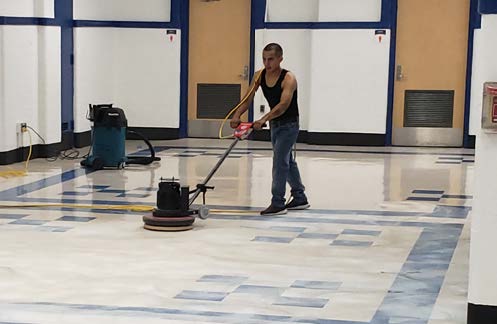Floor Prep Awareness in the Commercial Industry
By Met Zade, COO, 212 Carpet | The Flooring Contractor Magazine | Fall 2020
Subfloor preparation for VCT Flooring Installation has always been a major topic for discussion in the flooring industry. Whether one is installing a commercial or residential floor. The two main concerns are always cost and time restraints. And although some clients choose to opt for “proper floor preparation,” this comes at the cost of creating a faulty finished floor product.
Although we see that in the commercial sector, a growing trend with more clients becoming more aware of just how critical it is to take the essential steps for the proper floor preparation. Commercial clients view floor preparation as a necessity instead of an add on option due to the benefit of prolonging the life of the newly finished floor.
VCT Flooring Installation for Schools
A recent VCT Flooring Installation for a client in numerous middle schools and elementary schools consisted of installing a brand new Armstrong VCT over the existing VCT. The project consisted of a substantial quantity of square footage that had to be installed on a very tight timeline. Our typical procedure was not a feasible option, which would have consisted of scrubbing and stripping the existing VCT, followed by waiting 5-10 days to make sure all the stripper was completely dry. The waiting period is necessary to ensure no traces of the stripper still on the old VCT. Moreover, the stripper must be completely dry between the joints, as when any new adhesive is applied, it would lose its bond if any traces of the stripper were left behind.
We had to come up with a solution that would cut the time but still properly prep the floor before installing the new VCT. Our solution was to use a low-speed buffer. There are a variety of different options available in the industry. We opted to use the Taylor Tools’ floor prep plus machine to buff the existing VCT with anywhere between 24 -80 grit sandpaper. In some cases, we would also use a sanding screen, as every subfloor is different. We evaluate the existing wax condition on the subfloor and determine which type of disc and grit would produce optimal results.
Once the wax is sanded off, it creates slight scarification to the vct/subfloor. Our next step is to prime the subfloor with Ardex P82. Once the primer has dried according to the manufacturer’s recommendations, we then skimcoat the complete subfloor with Ardex feather finish.
This process has proven to produce a solid subfloor preparation when dealing with extreme timelines and large quantities to ensure a long-lasting, properly installed new finish floor on top of an existing VCT.
*Process above cannot and has not been done on any VAT as any mechanical machines used on VAT is against the law and our protocols.*

